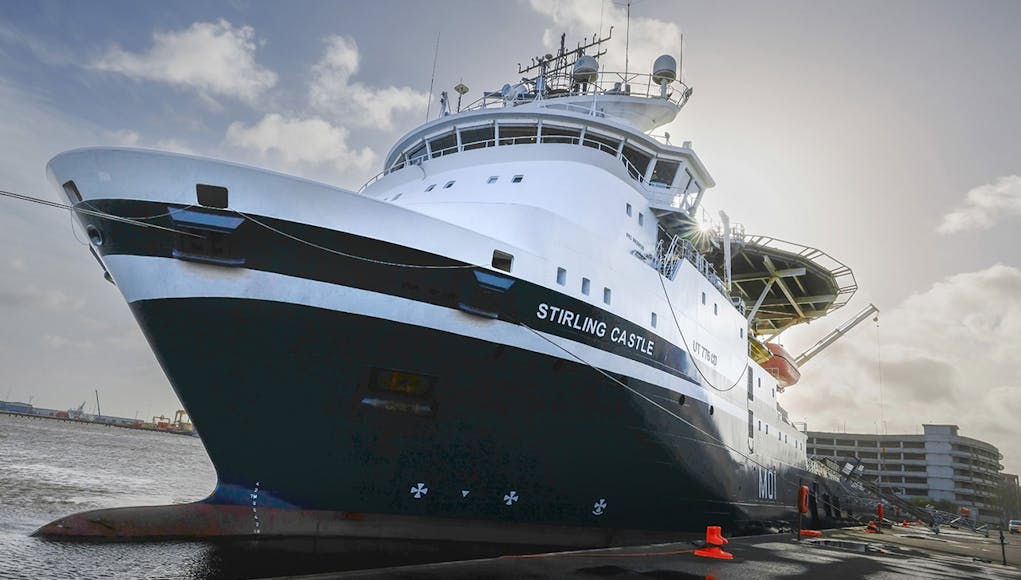His Royal Highness The Duke of Edinburgh today joined the Dedication Service of a new Naval ship which will help safeguard UK waters from underwater threats.
The ship marks a move away from traditional minehunting, embracing cutting-edge technology as she acts as a ‘mother ship’ for an array of remotely-operated and autonomous systems which will scour home waters looking for mines.
With RFA Stirling Castle due to begin operations later this year, a break from training offered the ideal opportunity to welcome the new ship into the RFA family in the presence of the Service’s Commodore-in-Chief, HRH The Duke of Edinburgh.
Procured and delivered by Defence Equipment & Support in less than a year, for the past few months RFA Stirling Castle has been on the Clyde working with the experts from the Royal Navy’s Mine Threat Exploitation Group (MTXG) at HM Naval Base Clyde. The Group’s Zulu Squadron are at the forefront of advancing new minehunting technologies, helping the Royal Navy to keep pace with the evolving threat from naval mines.
“Some of the new, high-tech, equipment includes Autonomous Surface Vessels and Uncrewed Underwater Vehicles (UUVs) capable of being operated remotely using a portable command centre. And that is where RFA Stirling Castle comes in. Not only can the portable command centre be located onboard the new vessel, but it can also be used to store, prepare, and deploy boats and UUVs on mine warfare and hydrographic survey tasks. RFA Stirling Castle is helping to extend the reach and effectiveness of Royal Navy mine hunting operations and to make it safer for those sailors whose job it is to locate and destroy mines.”
The ship is operated by 27 RFA officers and crew, augmented by 15 Royal Navy minehunting specialists on operations – with room onboard for up to 100 more personnel depending on the mission. There are plans to acquire up to three additional ships to perform the role of mine countermeasures command and support from the mid-2020s.
|














Interesting. I think it’s the first time I’ve heard “home waters” in this context. I never really understood how she was supposed to defend herself if overseas.
The priority is to make sure the RN can put to sea.
Absolutely right.⛵
Next round of cuts?
Indeed mine hunting in Home waters we’ve been doing that task along with Route surveys for decades but not with Civilians in charge of the vessel
If we hadn’t sold or scrapped our minesweeper capabilities, we might not need
Watched Forces Net oooh its got a Sauna that must of sold it for the MOD we had one on the Stenna was made unusable because someone put some wet Sheep fleeces on the benches and whacked the heat up the Civvies weren’t too happy about that
Remember when the plan was to move mine hunting to UAVs operated from surface warships? Acquiring motherships like this from commercial sources is far better. It is also more affordable than the bespoke platforms Belgium and the the Netherlands have ordered. Whether 4 are enough, I’m not sure.
Along with Proteus, one of the best decisions made by/ for the RN in recent years.
Yeah, maybe a good idea would be to equip fighting ships with mine hunting drones. The idea is not to turn frigates into mine hunters, but to give fighting ships the ability to deal with mines if they encounter them.
I’m fine with using vessels built to commercial standards as motherships, but 4 won’t be enough and I’d rather a common class than buying a hodgepodge of second hand platforms.
I’m. Fine with commercial ships being sued in.a military role. TheBAE plans to convert the argus sister ship to a HLP IS , I THINK An opportunity missed especially when ocean was sold without a replacement in place ref: navy lookout oldest royal navy ship article.
Wste of mone and resources should be painted. Grey with a RFA pennant number RFA flavour of the month maybe r